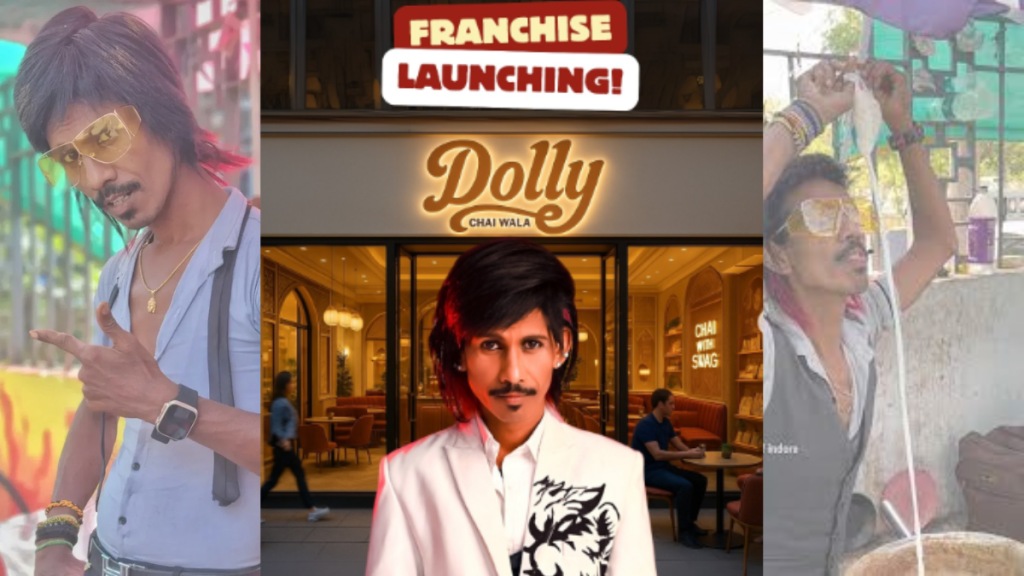On most days, Sunil Patil, already a social media celebrity and tea seller in Nagpur known for his flamboyant style, neon attire, and theatrical tea, pours outside the VCA stadium. His flair had earned him steady attention on social media, and he had built a loyal following long before the world noticed. But in February 2024, when a video surfaced of Microsoft co-founder Bill Gates sipping his tea, Dolly Chaiwala’s visibility shifted from viral to national. The clip amplified his already growing brand, turning him into a cultural icon almost overnight.
What began as a street-side spectacle is now taking structured form. On July 11, 2025, Dolly announced a pan-India franchise program. The response was swift and staggering: 1,609 applications in just 48 hours. The “Dolly Ki Tapri” model, with investment options starting at Rs 4.5 lakh, has struck a nerve, not just with small-town entrepreneurs but with marketers, investors, and brand strategists alike. Why the frenzy? And more importantly, can a brand built around viral social media frenzy evolve into a sustainable national franchise?
From meme to market
Dolly’s popularity may have been catalysed by social media, but his business instincts are proving equally shrewd. His franchise model, branded under Dolly Ki Tapri, is tiered, offering carts (Rs 4.5–6 lakh), stores (Rs 20–22 lakh), and flagship cafés (Rs 39–43 lakh) across cities. The deliverables include training in his signature “performance pour,” digital content templates, a pre-mix supply chain, and weekly audits to ensure brand uniformity. Every outlet is required to post at least three reels per week.
“It’s not just the tea that’s being sold—it’s the experience,” Gopa Menon, Co-founder and COO of TheBlurr, told financialexpress.com. “What’s scalable isn’t just the product, but the theatre of it. Dolly has built his brand around a consumable item with repeat-purchase potential, but elevated it with storytelling and spectacle.”
Crucially, this isn’t a one-size-fits-all rollout. The tiered pricing and model variations show a clear understanding of franchise economics and capital access across market segments. For small-town franchisees with limited capital, the cart model offers a low-risk entry. For investors targeting high footfall zones, the flagship café format offers greater margin and branding opportunity.
The power of relatability
In an age where polish was once equated with professionalism, Dolly offers something different: imperfection, confidence, and charisma, all served in a kulhad served with a funky expression. “Consumers are increasingly drawn to what feels real and relatable,” Ambika Sharma, Founder and Chief Strategist at Pulp Strategy, said. “Dolly doesn’t need polish. He stands for something authentic. His visual recall and emotional imprint are things most brands spend crores trying to engineer.”
This sentiment is echoed by Ramya Ramchandran, Founder and CEO at Whoppl. “Franchise models usually work because they’re formulaic. But here, Dolly is the formula. He’s hyper-local, but his appeal is universal because it feels personal. That’s the challenge—and the opportunity.”
Indeed, it’s a challenge many personality-driven brands face: how do you scale something rooted so heavily in one individual? The answer lies in systematising the spectacle. That’s precisely what Dolly appears to be doing: building a backend infrastructure that doesn’t depend solely on his presence. New franchisees must pass a flair exam to earn the “golden ladle,” undergo barista choreography training, and follow strict SOPs. The use of digital tools, like QR-based loyalty programs and cloud-based POS systems that auto-post Instagram stories, further attempts to bridge the charisma gap.
A shortcut to visibility
For brands and advertisers, the appeal lies not just in Dolly’s theatrics but in his reach. With over 5 million Instagram followers and 2 million YouTube subscribers, Dolly commands a digital audience larger than some television channels. As Yasin Hamidani, Director at Media Care Brand Solutions, puts it, “In today’s attention economy, visibility often outweighs perceived likability. Collaborating with Dolly is seen as a marketing shortcut—riding on an existing audience base.”
This attention also translates into potential footfall. “He’s already a walking brand,” Sharma noted. “The stores will inherit the buzz.” But she also adds a word of caution: “Scaling without diluting that identity will be the real test.”
While Dolly may not fit the mould of conventional brand ambassadors, his presence taps into what Menon calls a “democratisation of celebrity.” In a country where economic aspiration and cultural pride coexist, Dolly’s rise symbolises a new kind of success story, one where “cringe” is redefined as charm, and local authenticity carries national appeal.
Can it last?
Still, the question remains: will the franchise model endure beyond the virality?
Experts believe it can, if managed with discipline. “The risks are significant,” Menon reiterated. “Personality-led brands face the authenticity paradox—how do you scale personal charisma? The answer lies in standardising quality and preserving the essence without becoming a caricature.”
Operationally, the venture is designed to be light on capital from the brand owner’s side, relying instead on franchisees to shoulder the investment. This allows for rapid expansion, but also creates variability in execution. Inconsistent quality or loss of the signature experience could erode consumer trust.
Whether Dolly becomes India’s MrBeast Burger or fizzles out like a passing meme will depend not just on his flair but on his franchisees’ ability to recreate the experience. But as of now, his theatre of tea is the hottest ticket in India’s F&B startup circuit.

